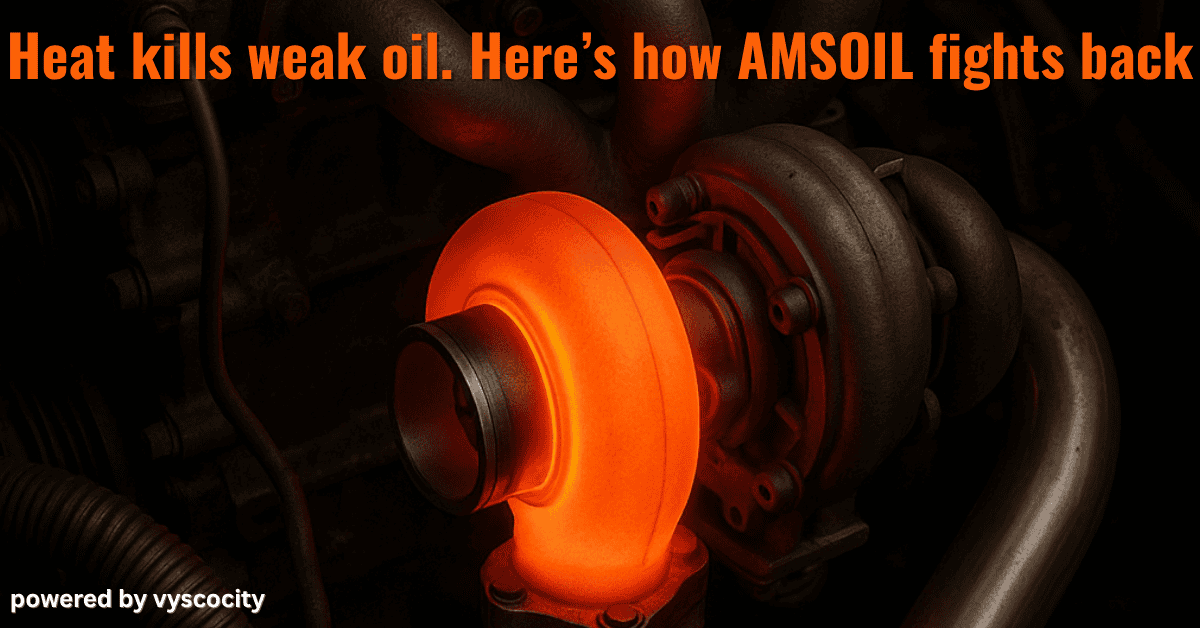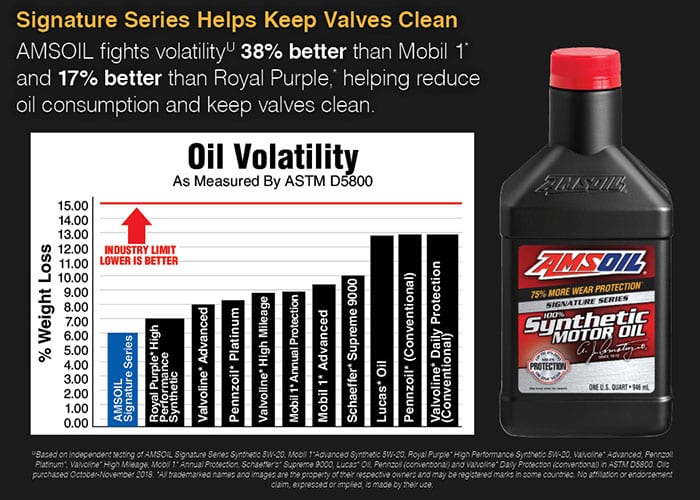AMSOIL and the Noack Volatility Test (ASTM D5800): Why It Matters

Why Low Volatility Is Critical for Engine Protection
What Is Oil Volatility?
Volatility refers to how easily engine oil evaporates when exposed to high temperatures. The higher the volatility, the more oil can “boil off,” leaving less lubricant behind to protect critical components. This is especially dangerous in modern engines where operating temps and stress are higher than ever.
The more volatile an oil is:
-
The more frequently you'll need to top off
-
The greater the chance of engine deposits
-
The less stable the oil becomes over time
This isn't just about convenience — high volatility leads to real wear, reduced fuel economy, and shorter engine life.
What Is the Noack Volatility Test? (ASTM D5800)
To measure volatility, oil manufacturers and certification bodies rely on the Noack Volatility Test, formally known as ASTM D5800.
Here's how it works:
-
A precisely weighed sample of oil is heated to 250°C (482°F) for one hour
-
A stream of dry air passes over the sample
-
As lighter components in the oil evaporate, their mass is carried away and captured
-
The remaining oil is weighed again
-
The percentage of mass lost is reported as the oil's volatility rating
The lower the percentage, the more thermally stable the oil.
How AMSOIL Led the Industry
Most oil brands began using the Noack test only when it became an industry requirement. AMSOIL, however, began using it voluntarily in 1985 — decades ahead of many competitors.
Founder Al Amatuzio recognized early that real-world engine performance was tied directly to how oils performed under extreme heat. While other companies relied on outdated tests like flash point, AMSOIL adopted the Noack test to measure real evaporation losses.
This decision allowed AMSOIL to:
-
Prove performance under thermal stress
-
Design oils that last longer and resist burn-off
-
Differentiate themselves before synthetic oils became mainstream
Why Modern Engines Demand Low-Volatility Oils
New engines are smaller, more powerful, and more thermally stressed than their predecessors. Turbochargers, gasoline direct injection (GDI), variable valve timing, and hybrid systems all raise engine temps and pressure.
These conditions:
-
Cause weak oils to vaporize quickly
-
Create deposits in turbo bearings and ring packs
-
Thicken oil through evaporation (raising vyscocity)
-
Accelerate wear during cold starts and high load
What evaporates matters:
-
Light oil molecules evaporate first
-
What remains is heavier, thicker, and less effective
-
Additive concentrations become unbalanced
-
Your oil no longer performs as intended
This is especially critical in turbocharged or performance engines, where oil volatility directly affects power, emissions, and reliability.
Industry Volatility Limits: What the Specs Say
To control volatility across the board, modern oil specs include maximum Noack values:| Spec | Noack Volatility Limit (% loss) | ASTM D5800 Used? |
|---|---|---|
| API SP | ≤15% | ✅ Yes |
| ILSAC GF-6A / GF-6B | ≤15% | ✅ Yes |
| GM dexos1 Gen 2 | ≤13% | ✅ Yes |
| ACEA C5 / A5 / B5 | Varies (typically 13–15%) | ✅ Yes |
| Ford WSS-M2C946-A | ≤13% | ✅ Yes |
Important note: Meeting these specs is the minimum — not the benchmark for high performance.

AMSOIL vs the Competition: Measured Performance
When AMSOIL first used the Noack test in the '80s, conventional oils had volatility loss rates of 17–25% — a huge loss of protective lubricant.
Today:
-
AMSOIL Signature Series: Often shows 6–8% loss
-
Mobil 1 (various lines): Typically 12–14%
-
Conventional blends: Still often test near 15–20%
This means:
-
AMSOIL loses half as much oil under heat compared to many synthetics
-
It remains within spec longer
-
It protects engines in towing, off-road, or turbo use where volatility really matters
Why You Might Notice Volatility Problems
You might be using a “high-quality” oil — but still topping up every few thousand kilometers or noticing sluggish cold starts.
Oil volatility could be the cause.
Symptoms of high-volatility oils:
-
More frequent top-offs between oil changes
-
Blue smoke from exhaust during hard acceleration
-
Engine knocking or increased noise
-
Poor cold start lubrication
-
Sticky rings and varnish buildup
These problems show up especially in:
-
Turbocharged gas engines
-
Heavy-duty vehicles idling for long periods
-
Performance cars used aggressively
-
Older engines with worn seals
🔧 Real-World Signs of Oil Volatility
Volatility isn't a lab-only problem. It shows up on your dipstick and in your repair bills.
If you experience:
-
Oil levels dropping between changes
-
Oil that smells burnt
-
“Check oil” lights between service intervals
…it's not necessarily your engine's fault. Your oil may simply be vaporizing too quickly.
Switching to a low-volatility synthetic like AMSOIL helps eliminate that variable. Less evaporation means longer-lasting protection — especially in hot, high-load environments.
Mobil 1 vs AMSOIL: The Volatility Breakdown
Mobil 1 is a respected name in the synthetic world, and it generally meets modern specs — but it doesn’t outperform them.
-
Mobil 1 Extended Performance: Tests between 11–14% Noack loss
-
AMSOIL Signature Series: Consistently 6–8%
That's a margin that matters, especially:
-
On hot summer days
-
During highway towing or plowing
-
In turbo engines operating under boost
AMSOIL doesn't just meet the limit — it exceeds it, giving you more protection, better vyscocity stability, and less oil consumption over time.
The Additive Angle: Why Stability Helps Everything Else
When lighter molecules boil off, the oil left behind isn't just thicker — it's imbalanced.
Your additive package (detergents, dispersants, anti-wear agents) was blended for a specific oil formula. If 10–15% of the oil disappears, that balance is disrupted.
That leads to:
-
Increased deposits in the engine
-
Reduced resistance to wear
-
Loss of fuel economy
-
Inconsistent protection over drain intervals
AMSOIL's lower volatility means its oil formulation stays chemically stable, not just physically present.
How to Choose the Right Low-Volatility Oil
Look for:
-
Noack value well below 13%
-
Mention of ASTM D5800 in product data sheets
-
Proven third-party or internal testing results
AMSOIL provides detailed Noack specs on many of its product technical data sheets (TDS). Very few brands do.
If you're running a turbocharged truck, a performance car, or a fleet of hard-working pickups, volatility control is a non-negotiable factor in oil performance.
🔗 Related Pages
❓FAQ | ASTM D5800 and Oil Volatility
Where to Buy / Become a Dealer
Looking to buy AMSOIL?
Powered by Vyscocity
Built by Vyscocity to help you get the job done right — whether you're riding, wrenching, or running a fleet.
Explore our products, try our free tools, and let us know how it works for you.
❓ Still stuck? Ask your question on Facebook →
No fluff. Just function.










